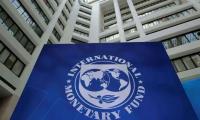ISLAMABAD: Keeping in view the impact of COVID-19 pandemic, Pakistan’s GDP is going to contract by 1.6 percent in the ongoing fiscal 2019-20 and will grow to 2.9 percent in the next financial year 2020-21 and the loans from IMF and other multilateral and bilateral donors will help to ease the balance-of-payments pressures in 2020 and over the next few years. The current account will remain in deficit in 2020-24. And Pak Rupee will depreciate against US dollar by Rs17.7 from an annual average of Rs160.8: US$1 in 2020 to Rs178.5: US$1 in 2024. Overseas workers' remittances will fall sharply in 2020 owing to the pandemic induced global economic slowdown. The unemployment rate is projected to increase manifold by 3.9 percent to 14.7 percent in current fiscal 2019-2020 from 10.8 in 2018-19 and is further forecast to plummet to 11.8 percent in 2020-21 and it will further go down to 9.4 percent in 2021-22 and stay at the same in 2022-23 and is projected to further decrease to 8.4 percent in 2023-24.
And the inflation rate is also projected to come down to average 7.4pc in 2020, from 9.4pc in 2019. However, the overall consumer priceinflation is expected to be at average 6.2pc a year in 2021-24. High food inflation in early 2020 and the impact of currency depreciation on import prices will keep inflationary pressures high, particularly amid the severe depreciation of the Pakistan rupee in the first quarter of the year. However, it is expected this intensification will be offset by the loss in demand resulting from a corona virus-related slowdown in private consumption.
This all has been forecast in a country report on Pakistan released from London on Thursday by the UK-based Economist Intelligence Unit (EIU), which has for 60 years been a source of information on business developments, economic and political trends, government regulations and corporate practice worldwide. The Economist Intelligence Unit also painted the political scenarios of Pakistan saying that opposition parties will continue to be hobbled by the legal challenges facing their leaders. It also mentioned that the coronavirus pandemic has increased the risk to political stability in the short term, as measures to slow the outbreak have led to curbs on religious activities and corporate disruption. The EIU expects this to stoke opposition from religious leaders and businesses.
"And more importantly, the armed forces will not only continue to shape Pakistan's foreign and security policy, but it is likely to expand their formal influence over economic policy-making during the forecast period." It also hoped that domestic policy in 2020 will focus on tackling the economic impact of the pandemic.
Coming to the fiscal situation, the Economist Intelligence Unit in its report says that the real GDP is expected to contract by 1.6pc in 2019-20, following the growth of 3.3pc in 2018/19. "The slowdown will be due primarily to the economic effects of the shutdown measures taken by the government to slow the spread of the coronavirus."
And the slowdown is expected to be concentrated in the fourth quarter of 2019-20, when the measures will be at their strictest. The economic impact of these measures will spill into 2020-21. Private consumption growth in that year will suffer from soured consumer confidence and a lingering increase in unemployment caused by the shutdown. Monetary and fiscal stimulus will begin to feed into the economy in that year, but this will not be enough to prop up growth.
The EIU also predicts the economic growth in 2020-21 to stand at 2.9pc, mainly because of a lower base of comparison from 2019-20, rather than any genuine improvement in underlying economic fundamentals. Economic growth will recover at a gradual pace from 2021-22 onwards, averaging 3.4pc annually on the back of a recovery in private consumption and fixed investment. Nevertheless, growth will continue to be hobbled by the government.
Mentioning about the monetary policy, the EIU says that the State Bank of Pakistan has loosened monetary policy aggressively in early 2020. Since March, the SBP has reduced the bench-mark policy rate by 425 basis points, to 9pc, and reduced the capital conservation buffer by 100 basis points, to 1.5pc.
It expects the SBP to loosen its stance further in the remainder of 2020, to provide liquidity to the banking sector during the crisis. The central bank will have more space to loosen monetary policy later in the year as inflationary pressures abate, amid weakening consumption and global fuel prices. It will maintain an accommodative stance in 2021 as the economy recovers and inflation continues to ease. It also mentioned that the Pakistan rupee depreciated by more than 7pc against the US dollar within the first three months of 2020, as investors fled to safe-haven markets in the face of disruption caused by the pandemic. The SBP's aggressive reduction of interest rates has also led to an outflow of foreign investment. The rupee stabilized in April, as concessional loans from multilateral organizations and an expected temporary freeze on debt repayment to G20 countries have helped to restore confidence in the currency. The EIU expects the rupee to continue to depreciate in 2020, but ultimately at a more stable rate, as the initial pandemic shock recedes. This depreciatory trend will persist over the rest of the forecast period, owing primarily to the persistent current-account deficit. The currency will depreciate from an annual average of PRs160.8:US$1 in 2020 to PRs178.5:US$1 in 2024.
Under the IMF programme, Pakistan has switched to a more lightly managed exchange-rate regime that is more reflective of market demand for the local currency. However, we do not expect the country to adopt a free-float regime. The SBP will therefore continue to operate a managed exchange-rate regime and will retain some influence over the Pakistan rupee's depreciatory trend. In view of the current-account deficit, this will provide a greater degree of control than would have been the case under a floating exchange-rate system.
Highlighting the external sector, the EIU report says the current-account deficit will continue to narrow in 2020. The deficit diminished sharply in 2019, after severe balance-of-payment pressures in 2017-18, when import growth ballooned to unsustainable levels. It expects merchandise imports (on a current-account basis) to contract by 20.1pc in 2020.
Import value compression will reflect lower global oil prices — Pakistan is a net oil importer — and a collapse in domestic demand resulting from disruption caused by the coronavirus. The EIU report expects import growth to pick up later in the forecast period, as import controls are relaxed and economic growth accelerates. It also pointed out saying that the demand for exports will be dampened by a slowdown in economic activity in Pakistan's top destinations, resulting from the global spread of the coronavirus. It forecast merchandise exports (on a current-account basis) to contract by 10.4pc in 2020, deepening the 0.2pc decline recorded in 2019, although exports will stabilize later in the forecast period. Nevertheless, this growth will remain below potential because of myriad supply-side constraints, including the slow adoption of technology, low labour productivity and a difficult local business environment.
Overseas workers' remittances will fall sharply in 2020 owing to the pandemic induced global economic slowdown. Low oil prices will depress economic growth in the Gulf economies, which are major employers of Pakistani overseas workers, further affecting remittance inflows. Nevertheless, inflows will dwarf outflows, leaving the secondary account in surplus and partially offsetting the trade deficit. Overall, the EIU expects Pakistan's external position to be much improved in 2020-24, aided by the US$6 billion, 39-month IMF extended fund facility (EFF) that began in July 2019, coupled with lending from other multilateral and bilateral donors. Although it expects the current-account deficit to widen from the equivalent of 1.6% of GDP in 2020 to 2.5% of GDP in 2024, the deficit will remain narrower both in absolute terms and as a percentage of GDP than it was in 2018.
Awami Muslim League chief appeared in the court with his lawyers Sardar Raziq and Sardar Shehbaz
Board meeting also allowed increase in business center and commercial area of hotel plots from 5 to 10 percent along...
Foreign exchange reserves currently stand at $8 billion, while Pakistan would also receive $1.1 billion IMF tranche:...
CM directed that the enforcement authorities be made functional in six months, and legislation in this regard be...
Pakistani soldiers and policemen stand guard outside the Haripur central jail. — AFP/FileWASHINGTON: The Pakistani...
Establishment Division has also issued an NoC to fill 465 civilian posts in the Ministry of Defence and 11 posts in...







